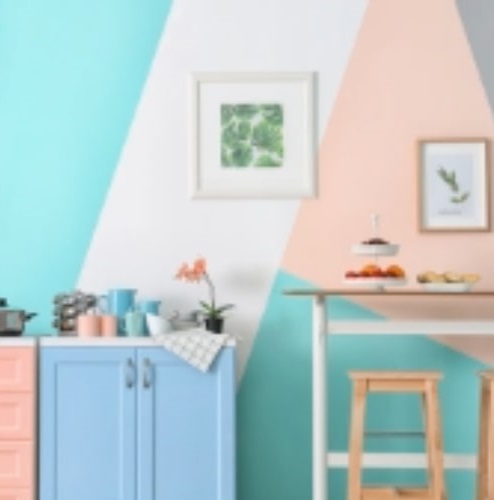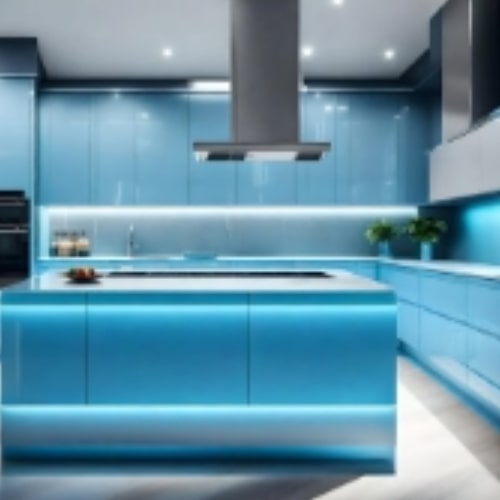When embarking on a kitchen remodel in Miami, selecting the perfect color is more than just a design choice—it’s a celebration of the city’s vibrant and eclectic spirit.
Miami’s renowned art deco architecture and lively cultural scene influence a bold and sunny palette that can make your kitchen feel as lively as the city itself.
From flamingo pinks to oceanic turquoises, the region’s design trends invite daring choices that reflect its energetic atmosphere.
This introduction will explore the trending kitchen colors in Miami, helping you to blend functionality with the flair unique to the Magic City.
What Color Should You Choose When Remodeling Your Kitchen? Design Trends in Miami
When embarking on a kitchen remodel, one of the first and most crucial decisions you’ll make involves the color scheme. This choice not only reflects your personal style but also impacts the space’s functionality and mood. In Miami, where design trends often blend vibrant energy with ocean-inspired serenity, selecting the right color can be particularly impactful.

Understanding the Importance of Color for Kitchen Design in Miami
Color is not just a matter of aesthetics; it significantly affects our mood and energy levels.
In the context of a kitchen, colors like red are believed to stimulate the appetite, while blue tones, which are less common in food, might reduce hunger.
Understanding these psychological impacts can guide you in choosing a color that aligns with how you want to feel in your kitchen.
The Miami Aesthetic: What Makes It Unique?
Miami’s unique blend of cultures and its tropical climate heavily influence local design choices.
Bright, sunny colors can reflect the city’s vibrant energy and diverse cultural background, while lighter hues might be used to create a cool, refreshing atmosphere that counteracts the heat.
Current Trends in Kitchen Colors in Miami
In Miami, current trends lean towards a mix of bold and pastel palettes.
Ocean blues, palm greens, and sandy beiges are popular, reflecting the natural beauty of Miami’s landscapes.
Meanwhile, vibrant yellows and turquoises can add a more energetic and tropical touch, reminiscent of Miami’s lively art scene and nightlife.
This introduction sets the stage for a detailed exploration into how colors can be intelligently used in your kitchen remodel, especially tailored to the sunny and spirited context of Miami.
Each subsequent section will build on this foundation, providing in-depth advice on integrating these concepts into a cohesive kitchen design.
Analyzing Miami’s Top Kitchen Color Trends
In Miami, the choice of kitchen colors often mirrors the city’s dynamic mix of tradition and modernity, creating spaces that are both welcoming and stylish. Whether you’re drawn to bold, statement-making hues or prefer a more subdued palette, understanding Miami’s top kitchen color trends can help you make an informed decision.

Bold and Bright: Embracing Vivid Colors
Miami’s penchant for vibrant colors is evident in its bold kitchen designs.
Examples include deep ocean blues that evoke the feel of the sea or fiery oranges that reflect the tropical sunsets.
These colors can be used on a feature wall, as cabinetry, or even for appliances and fixtures to create focal points that captivate and energize.
Natural and Neutral: A Softer Approach for Kitchen Colors
Neutral tones, such as soft grays, warm ivories, and sandy beiges, offer a timeless elegance that can also make kitchens feel more spacious and open.
These colors reflect Miami’s beachside elements and can serve as a perfect backdrop for layering textures or for adding pops of more vibrant colors through decor and accessories.
The Rise of Pastels in Miami’s Modern Kitchens
Pastels are gaining popularity in Miami kitchens for their ability to soften interior spaces and create a tranquil, airy atmosphere.
Colors like mint green, soft peach, and pale pink can introduce a sense of calm and serenity, ideal for a space where comfort and relaxation are as important as functionality.
This section of the article not only identifies the current color trends in Miami kitchens but also offers real examples and psychological insights to help homeowners understand how these trends can be adapted to their own spaces.
Each color trend is analyzed to showcase its potential impact on the overall feel and functionality of the kitchen, ensuring readers have a comprehensive understanding of their options.
How to Choose the Right Color for Your Kitchen
Selecting the ideal color for your kitchen involves more than just following trends; it’s about creating a space that resonates with your personal style and meets your functional needs. In this section, we delve into practical considerations and tips to help you decide the best color scheme for your kitchen remodel in Miami.

Considering Lighting and Space
The amount and type of natural light your kitchen receives can dramatically affect how colors appear.
In Miami, with its abundant sunshine, bright colors might appear more vivid, while darker shades could become overwhelming during peak sunlight hours.
It’s important to consider how light interacts with your chosen colors at different times of the day to ensure consistency and comfort.
Complementing Your Home’s Overall Miami Design
Your kitchen should not only be a reflection of your personal taste but also complement the overall design and architecture of your home.
For instance, a modern Miami beach house might benefit from cool blues and whites, which enhance the coastal vibe, whereas a more traditional home might look better with richer, warmer tones.
Practical Tips for Selecting Kitchen Colors in Miami
When choosing colors for your kitchen in Miami, consider the durability and maintenance required for different finishes.
Darker colors might hide stains and wear better, but they can make a space feel smaller.
Light colors might require more frequent cleaning but can make a kitchen feel larger and more inviting.
The Role of Cabinetry for Kitchen Color Choices in Miami
Cabinetry is often the most prominent feature in a kitchen and plays a critical role in defining the room’s overall aesthetic. In Miami’s diverse and trend-forward market, the color of your kitchen cabinets can either anchor your design or serve as a dynamic focal point.

Popular Kitchen Cabinet Colors in Miami
White remains a perennial favorite for kitchen cabinets in Miami due to its bright, clean appearance that reflects light and enhances the sense of space.
Gray cabinets offer a softer alternative that still maintains neutrality while adding a bit more depth.
For those looking to make a bolder statement, vibrant hues such as turquoise or lime green can be striking choices that reflect Miami’s lively culture
Mixing and Matching Colors with Cabinets
To create a balanced look, consider the color wheel when selecting complementary colors for your cabinets and walls.
For instance, a navy blue cabinet looks lovely when combined with soft gray walls, and light wood tones can complement a pastel yellow. This strategy helps to create a cohesive yet visually interesting kitchen environment.
Future Miami Trends in Kitchen Cabinet Colors
Looking ahead, the trends in Miami are shifting towards more sustainable and personalized color choices.
Earth tones and nature-inspired colors are becoming popular as people seek to create a more grounding and calming kitchen environment.
Additionally, technology enables more customized color options, allowing homeowners to tailor their choices to their exact preferences.
Countertops and Backsplashes: Enhancing Color Dynamics in Miami
Countertops and backsplashes are not only functional surfaces but also key elements in defining the kitchen’s character. The right choices here can complement your cabinetry and reinforce your desired atmosphere. In Miami, where design can be as daring as it is diverse, selecting the right materials and colors for these features is crucial.

Choosing Countertops to Complement Cabinet Colors
When selecting countertops, you have the option to either match or contrast with your cabinetry.
A matching color scheme can create a harmonious, seamless look, which is excellent for smaller kitchens to enhance the sense of space.
Contrasting colors, on the other hand, can define spaces and add depth; for example, dark granite countertops with light-colored cabinets can offer a striking and sophisticated appearance.
Innovative Backsplash Ideas
The backsplash is a perfect place to introduce personality and flair.
In Miami, colorful tiles with intricate patterns can echo the city’s Art Deco heritage or its vibrant cultural mosaic.
Alternatively, modern materials like recycled glass or metallic finishes can add a contemporary edge that reflects light and adds to the overall ambiance.
The Impact of Material Choices on Miami Kitchen Aesthetics
The choice between natural stone and synthetic materials can significantly affect both the look and functionality of your kitchen.
Natural stones, like marble or granite, offer unique patterns and colors that are never exactly the same, adding an exclusive luxury feel.
Synthetics, like quartz or laminates, provide a more uniform look and often come in a broader range of colors and patterns, which can be advantageous for achieving a specific design vision.
Integrating Appliances and Fixtures into Your Miami Kitchen Color Scheme
Appliances and fixtures are essential components of any kitchen remodel, significantly influencing both functionality and style. In Miami, where design is as much about form as function, the integration of these elements into your color scheme can make or break the visual harmony of the space.

Stainless Steel vs. Colorful Appliances
Stainless steel appliances remain a popular choice for their sleek, modern look and ease of integration into any kitchen design.
However, there is a growing trend towards colorful appliances in Miami, where bold colors like red, blue, or even green are used to add a playful touch and serve as a statement piece in the kitchen.
Selecting Fixtures That Enhance Your Color Palette
Fixtures, including faucets and cabinet hardware, offer an opportunity to complement or accentuate the kitchen’s color scheme.
In Miami, brushed nickel and matte black are popular for their understated elegance, while brass or copper fixtures can add warmth and a hint of luxury, especially in kitchens with darker or neutral tones.
The Role of Technology in Kitchen Color Choices
Technological advancements have introduced new dimensions to kitchen design, particularly through smart appliances and LED lighting systems.
These technologies allow for dynamic color changes and can be adjusted to fit the mood or time of day, providing not only convenience but also a way to enhance or modify the kitchen’s color scheme at the touch of a button.
Color Psychology and Its Application in Kitchen Design
The colors chosen for a kitchen do more than just complement the architectural style—they also have the power to influence mood, behavior, and even appetite. In the vibrant setting of Miami, where both food and design culture are celebrated, understanding the psychological impact of color can help create a kitchen that’s not only beautiful but also emotionally resonant.

Kitchen Colors That Stimulate Appetite and Conversation
Colors like red and yellow are known to stimulate the appetite and can make dining experiences more engaging and enjoyable.
Implementing these colors in a Miami kitchen can be done through accent walls, decorations, or small appliances.
These warm tones can also encourage conversation, making the kitchen a lively hub of interaction, particularly when entertaining guests.
Kitchen Colors for a Calming and Soothing Environment
To create a calming and soothing environment, shades of blue and green are ideal.
These colors evoke feelings of tranquility and serenity, reminiscent of the Miami coastline and lush landscapes.
Using these colors in a kitchen can help reduce stress and make the act of cooking more therapeutic. They work well in busy households where the kitchen serves as a retreat.
Utilizing Color to Make the Kitchen Look Spacious
Light colors such as white, cream, or soft pastels can make a kitchen appear larger and more open. These colors reflect more light, enhancing the sense of space.
Strategic use of mirrors and reflective surfaces can amplify this effect, making even small Miami kitchens feel more expansive.
Contrasting colors can be used for accenting areas without closing down the perceived space, such as on backsplashes or kitchen islands.
How Texture Influences Kitchen Color Perception
Texture plays a pivotal role in kitchen design, affecting not just the tactile experience but also how colors are perceived. In the sunlit environments of Miami, where light plays across surfaces throughout the day, the interplay of texture and color can dramatically enhance the aesthetic of a kitchen.

The Interplay Between Kitchen Materials and Colors
Different materials will reflect or absorb light differently, which in turn affects how a color is perceived. Glossy surfaces, such as polished granite or lacquered cabinets, reflect more light and can make colors appear more vibrant and intense.
Conversely, matte surfaces like wood or chalky paint finishes absorb light, which can soften the color’s appearance and create a more muted look.
In Miami’s bright environment, these effects are magnified, making the choice of texture as important as the choice of color.
Choosing Textures That Complement Your Kitchen Color Choices
When selecting materials, consider how their inherent textures will interact with your chosen color scheme.
For instance, rough textures like brushed metal or raw wood are excellent for earthy tones and can enhance the natural qualities of green or brown hues.
Smooth textures, such as marble or ceramic, work well with cooler colors, providing a sleek and modern look that complements shades of blue, gray, or white.
These combinations should align with both the aesthetic and practical functions of the kitchen, enhancing its overall harmony and design coherence.
The Role of Glossy and Matte Finishes
The finish of a material not only affects its durability and maintenance but also its color perception. Glossy finishes tend to enhance the depth and saturation of colors, making them pop more dramatically.
This can be particularly effective in a kitchen where you want to create a focal point, such as on a central island or the lower cabinets.
Matte finishes, on the other hand, offer a more subdued and sophisticated look that absorbs light, reducing glare and softening the room’s overall tone.
These finishes can be especially appealing in larger or more brightly lit spaces, where controlling light reflection is necessary.
CONCLUSION
As we’ve explored throughout this article, choosing the right color for your kitchen remodel in Miami involves more than just picking your favorite shade. It’s about understanding the interplay of light and color, the psychological effects of hues, and how materials can influence your perception of color. The right choices can transform your kitchen into a space that enhances mood, increases comfort, and adds value to your home. Whether you’re drawn to the vibrant, bold colors that mirror Miami’s lively culture or prefer the calming influence of softer, neutral tones, your kitchen is a canvas for your personal aesthetic and functional needs.

FAQ
What are the safest colors for kitchen resale value in Miami?
When considering resale value, neutral colors such as white, beige, and light gray tend to be the safest choices.
These colors appeal to a broad audience and can serve as a blank canvas, allowing potential buyers to envision their own ideas and styles in the space.
They reflect light well, making the kitchen appear larger and more inviting, which is a crucial factor for resale.
How do you add personal style without overwhelming with color?
To incorporate personal style without overwhelming the space, consider using bold colors as accents rather than primary color schemes.
For example, a vibrant backsplash, colorful appliances, or decorative items can add personality while the rest of the kitchen remains more neutral.
This strategy allows you to infuse your kitchen with character and uniqueness without compromising the overall harmony and appeal of the design.
What are common mistakes in kitchen color selection?
A common mistake in kitchen color selection is neglecting to consider the natural and artificial lighting of the space, which can lead to colors looking different than expected.
Another pitfall is choosing trendy colors that may quickly go out of style or personal preferences that are too specific, which could be a turn-off to future buyers.
Lastly, failing to test colors in the actual environment before making a final decision can result in dissatisfaction with the finished look.
By addressing these frequently asked questions, we hope to equip you with the knowledge and tools necessary to make informed decisions when remodeling your kitchen.
The right color choices not only reflect your personal style but also enhance the functionality and aesthetic appeal of your kitchen, making it a joyful place for both everyday use and special gatherings.
